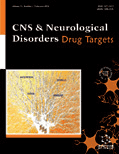
NEUROPHARMACOLOGY
Scope & Guideline
Exploring the Intricacies of Mind and Medicine
Introduction
Aims and Scopes
- Neuropharmacological Mechanisms:
Researching the biochemical and physiological mechanisms through which drugs affect the nervous system, including receptor interactions and signaling pathways. - Behavioral Pharmacology:
Examining the effects of drugs on behavior and cognition, particularly in relation to addiction, anxiety, depression, and other neuropsychiatric conditions. - Neurodegenerative Disorders:
Investigating pharmacological interventions for conditions such as Alzheimer's disease, Parkinson's disease, and multiple sclerosis, focusing on both neuroprotective and restorative strategies. - Developmental Neuropharmacology:
Studying the effects of pharmacological agents during critical periods of development, including prenatal exposure and adolescent drug use. - Innovative Therapeutics:
Exploring novel compounds and treatment strategies, including cannabinoids, psychedelics, and other emerging therapies for various neurological disorders. - Neuroinflammation and Pain:
Researching the role of neuroinflammation in chronic pain conditions and the potential for pharmacological modulation of these pathways. - Translational Research:
Bridging laboratory findings with clinical applications to develop effective therapies for neurological and psychiatric disorders.
Trending and Emerging
- Psychedelics and Mental Health:
Growing interest in the therapeutic potential of psychedelics for treating mental health disorders, including depression and PTSD, is evident in the increasing number of publications. - Cannabinoid Research:
Research exploring the therapeutic applications of cannabinoids in various conditions, including chronic pain, anxiety, and neurodegeneration, is expanding rapidly. - Neuroinflammation and Neuropathic Pain:
There is an increasing focus on understanding the role of neuroinflammation in chronic pain conditions and developing treatments that target these pathways. - Microbiome-Gut-Brain Axis:
Emerging studies exploring the connections between gut microbiota and neurological health, including implications for psychiatric disorders and neuroinflammation. - Personalized Medicine Approaches:
Research emphasizing the need for tailored pharmacological treatments based on genetic, environmental, and individual patient factors is gaining traction. - Neurotechnology and Drug Delivery Systems:
Innovations in drug delivery methods, such as nanotechnology and targeted delivery systems, are becoming a significant focus within the field. - Longitudinal Studies in Neurodevelopment:
There is an increasing trend toward longitudinal studies examining the effects of early-life exposures on long-term neurodevelopmental outcomes.
Declining or Waning
- Traditional Opioid Research:
Research on classic opioids and their mechanisms is becoming less prominent as newer classes of pain medications and non-opioid alternatives gain attention. - Basic Neurotransmitter Studies:
Studies focused solely on neurotransmitter systems without considering the broader context of neuroinflammation and neuroimmune interactions are less frequently published. - Pharmacokinetics of Established Drugs:
There is a noticeable decline in studies centered around the pharmacokinetics of well-established drugs, as the field shifts towards novel compounds and personalized medicine approaches. - Animal Models of Substance Use Disorder:
Research using traditional animal models for substance use disorders is becoming less frequent, with a shift towards more complex models that incorporate social and environmental factors. - Single-Agent Pharmacology:
Research focusing solely on the effects of single agents without considering polypharmacy or combination therapies is waning as the complexity of treatment regimens is recognized.
Similar Journals

BEHAVIOURAL PHARMACOLOGY
Fostering Collaboration in Behavioral Science and PharmacologyBehavioural Pharmacology is a distinguished academic journal published by Lippincott Williams & Wilkins, focusing on the intricate relationship between pharmacology, psychiatry, and behavioral science. With an ISSN of 0955-8810 and an E-ISSN of 1473-5849, this journal serves as a vital platform for researchers and professionals dedicated to exploring the pharmacological mechanisms underlying behavior and mental health. Operating with a robust track record since its inception in 1992, it has established itself in the academic community, as reflected by its Q3 rankings in both the pharmacology and psychiatry categories for 2023. Additionally, the journal holds a credible position in Scopus rankings, with a percentile ranking indicative of significant contributions to the fields of pharmacology and psychiatry. Aimed at advancing knowledge and disseminating research in the behavioral pharmacology domain, this journal is an essential resource for students, researchers, and clinical professionals seeking to stay at the forefront of this rapidly evolving field. While it is not an open access journal, the rich content and research findings published here continue to foster collaboration and innovation within the community, making it a crucial reference point for current and future studies.

INTERNATIONAL JOURNAL OF NEUROPSYCHOPHARMACOLOGY
Advancing knowledge in neuropsychopharmacology.The INTERNATIONAL JOURNAL OF NEUROPSYCHOPHARMACOLOGY, published by OXFORD UNIV PRESS, is a leading open-access journal in the fields of pharmacology and psychiatry, with an impressive impact factor reflecting its prominence in academic research. Since its inception in 1998, the journal has provided a crucial platform for the publication of high-quality research, offering insights into the effects of neuropharmacological agents on mental health. As of 2023, it ranks in the Q1 category for both Pharmacology and Psychiatry & Mental Health, underscoring its relevance and authority within the scientific community. With notable rankings in various medical subspecialties, it attracts contributions that advance our understanding of psychiatric disorders and therapeutic strategies. The accessible nature of the journal, following its transition to open access in 2015, has expanded its reach, making knowledge and findings readily available to researchers, professionals, and students globally. This commitment to disseminating impactful research ensures the journal remains at the forefront of neuropsychopharmacological advancements.

Journal of Neuroimmune Pharmacology
Exploring the Intersection of Neuroscience and PharmacologyThe Journal of Neuroimmune Pharmacology, published by Springer, is a premier academic journal dedicated to advancing the field of pharmacology intersecting with neuroscience and immunology. With an outstanding impact factor and proudly positioned in the Q1 quartile across multiple categories, this journal showcases cutting-edge research that enhances our understanding of the neuroimmune system and its pharmacological implications. Established in 2006 and continuing through 2024, it serves as a vital resource for researchers, professionals, and students alike, offering insights into the mechanisms of drug action, disease processes, and therapeutic strategies. As a testament to its excellence, the journal ranks prominently in Scopus metrics within its discipline, making it an essential platform for disseminating high-quality research that drives innovation in immunology, allergy, neuroscience, and pharmacology.

Neuropsychopharmacology Reports
Bridging gaps in mental health research and treatment.Neuropsychopharmacology Reports is a leading open-access journal published by WILEY, dedicated to advancing the fields of clinical psychology, pharmacology, psychiatry, and mental health. Established in 2018, the journal aims to disseminate high-quality research findings, critical reviews, and innovative methodologies that elucidate the complexities of neuropsychopharmacology in enhancing mental health outcomes. With an impressive impact indicated by its Q2 rankings in several categories including Clinical Psychology and Pharmacology (medical) as of 2023, Neuropsychopharmacology Reports stands out as a vital resource for researchers, professionals, and students keen on exploring the interplay between pharmacological interventions and psychological well-being. The journal’s open-access nature ensures that critical advancements in this rapidly evolving field are readily available to a global audience, fostering collaboration and discourse among scholars and practitioners alike. Building on its indexed status with Scopus, the journal is positioned as a noteworthy contributor to ongoing discussions and developments in psychiatry and medical pharmacology.

MOLECULAR PHARMACOLOGY
Elevating Understanding of Molecular Drug ActionsMOLECULAR PHARMACOLOGY, published by the American Society for Pharmacology and Experimental Therapeutics, is an influential peer-reviewed journal dedicated to advancing the field of pharmacology through comprehensive research on molecular mechanisms of drug action. With an impressive historic convergence from 1965 to 2024, this journal plays a pivotal role in disseminating high-quality research, showcasing significant findings that impact both clinical and experimental pharmacology. Notably, it holds a distinguished Q1 ranking in Pharmacology and a Q2 ranking in Molecular Medicine as of 2023, reflecting its prominence in the academic community. Researchers and practitioners engaged in pharmacological studies will benefit from the journal’s focus on new therapeutic strategies, drug development, and the molecular basis of drug action. While MOLECULAR PHARMACOLOGY is not an open-access journal, it offers a wealth of knowledge behind a subscription model, ensuring that contributors and readers maintain a high standard of academic rigor. Address all inquiries to the editorial office located at 9650 Rockville Pike, Bethesda, MD 20814-3995, United States.

Neuropeptides
Unraveling the Mysteries of Biological ProcessesNeuropeptides is a prestigious, peer-reviewed journal published by Elsevier, focusing on the critical role of neuropeptides in various biological processes and their implications in cellular and molecular neuroscience, endocrinology, and neurology. With an impact factor reflecting its influence in the field and a diverse audience ranging from researchers to healthcare professionals, the journal serves as an essential platform for the dissemination of groundbreaking research from 1980 to 2024. Adhering to high academic standards, Neuropeptides holds a Q3 ranking in Cellular and Molecular Neuroscience and Endocrine and Autonomic Systems, alongside a solid Q2 ranking in both Endocrinology and Neurology. This positions the journal at the forefront of its disciplines, contributing valuable insights into the understanding of neuropeptide functions in health and disease. By not operating as an Open Access journal, it ensures sustainability in the publishing process while upholding rigorous review standards. Researchers, professionals, and students are encouraged to engage with the findings published in this journal, which plays a vital role in advancing knowledge and fostering collaboration within the neuroscientific community.

CNS & Neurological Disorders-Drug Targets
Unraveling the Complexities of the Central Nervous SystemCNS & Neurological Disorders-Drug Targets is a distinguished journal that focuses on contemporary research and advancements in the realms of neurology, pharmacology, and drug development. Published by Bentham Science Publishers, this journal serves as an essential platform for researchers, professionals, and students interested in the intricate workings of the central nervous system and the evolving strategies to target neurological disorders through pharmacological innovations. With a robust impact factor reflecting its academic relevance, CNS & Neurological Disorders-Drug Targets is categorized in the Q2 quartile for both Medicine (miscellaneous) and Pharmacology, and Q3 for Neuroscience in the 2023 rankings. The journal's Scopus rankings further reinforce its authority, positioning it within the top half of its categories. Operating out of the United Arab Emirates, the journal has been a loyal contributor to the scientific discourse since its inception in 2006 and will continue until at least 2024, ensuring a dynamic channel for the latest findings and reviews in this vital field. As an open-access publication, it prioritizes accessibility, thus fostering a wider impact among scholars and practitioners alike, making it a valuable resource for all stakeholders in neurological and pharmacological research.

PSYCHOPHARMACOLOGY
Enhancing Knowledge at the Intersection of Pharmacology and PsychologyPSYCHOPHARMACOLOGY is a leading peer-reviewed journal specializing in the field of pharmacology, specifically focusing on the effects of drugs on behavior, cognition, and emotion. Published by Springer, this esteemed journal has established itself as a pivotal resource for researchers and professionals since its inception in 1959, maintaining its relevance and rigor in the ever-evolving landscape of psychopharmacological research. With an impressive impact factor and ranking in the top quartile (Q1) of the Pharmacology category in 2023, it consistently publishes high-quality studies that contribute to both academic inquiry and clinical practice. The journal's scope includes original research, theoretical papers, and reviews, fostering a multidisciplinary dialogue among psychologists, psychiatrists, pharmacologists, and neuroscientists. As the field of psychopharmacology continues to grow, PSYCHOPHARMACOLOGY remains dedicated to disseminating innovative findings, operationalizing complex concepts, and enhancing the understanding of drug mechanisms and their implications for mental health. This commitment to excellence positions PSYCHOPHARMACOLOGY as an indispensable tool for those seeking to advance their knowledge and research in pharmacology.

ANNALS OF NEUROLOGY
Exploring Innovations in Neurological ResearchANNALS OF NEUROLOGY, published by Wiley, stands as a leading journal in the field of neurology, renowned for its rigorous peer-reviewed articles that contribute significantly to the understanding of neurological disorders and advances in clinical practices. With an impressive impact factor and ranked Q1 in both neurology and clinical neurology categories, this journal positions itself among the top repositories of cutting-edge research, indexed in Scopus with exemplary ranks in the 98th and 97th percentiles respectively. Since its inception in 1977 and with a commitment to excellence extending to 2024 and beyond, ANNALS OF NEUROLOGY aims to disseminate groundbreaking studies and foster dialogue within the academic community, making it an essential resource for researchers, healthcare professionals, and students dedicated to neurology. Although it does not currently offer open access, its accessibility through institutional subscriptions facilitates widespread scholarly engagement.

IBRO Neuroscience Reports
Bridging gaps in neuroscience research and understanding.IBRO Neuroscience Reports, published by Elsevier, is a pivotal open-access journal dedicated to advancing the field of neuroscience. With its ISSN 2667-2421, the journal serves as a vital platform for researchers, professionals, and students alike, showcasing innovative research and interdisciplinary studies that span various aspects of neuroscience. Since its inception in 2021, and with a planned convergence through 2024, the journal has quickly established itself within the academic community, currently holding a Q3 category ranking in the field of Neuroscience (miscellaneous) and a Scopus rank of #77 among 113 in General Neuroscience, reflecting its ongoing commitment to quality and relevance. The accessibility of research articles ensures that critical findings are widely disseminated, fostering collaboration and dialogue within the neuroscientific community. Researchers and professionals are encouraged to contribute to this dynamic journal, reinforcing its role in shaping the future of neuroscience research.